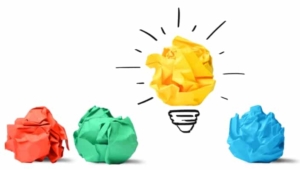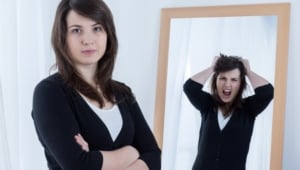Creativity: 10 tips and 5 no-gos for inspiring your imagination (+ quotes)

Ingenuity and creative spirit are indispensable traits nowadays. Tapping into your creative side is the key to coming up with innovative ideas. We have put together a list for you containing ten dos and five don’ts to show you how to foster and train your creativity.
Creativity: the word on everyone’s lips and a winner in anyone’s book. It is the source of innovation and the key to finding alternative solutions to your problems.
Creativity: a definition

Creativity: a definition
Being an expert in your field is no longer enough in many industries and professions these days. Creative approaches are increasingly in demand, and any new ideas and solutions to problems should be unconventional too.
Not everyone is able to stay one step ahead of others and come up with creative, extraordinary ideas round the clock. Nevertheless, creativity is a skill that has never been more sought after at work than it is today. But what does it take to be creative?
Creativity (from the Latin creatio = creation) describes a person’s ability to think outside the box, come up with new, original ideas, and develop valuable solutions to problems.
Creativity as a skill is demanded and encouraged in many professions. It is practice-oriented and involves applying a creative approach in line with certain situations, i.e. the ability to draw on your creativity in specific relation to the repertoire of knowledge you hold.
To this end, creativity is goal-oriented and has a certain orientation and direction. Other terms for creativity are inventiveness, innovation, inspiration or imagination.
The four pillars of creativity
U.S. scientist Mel Rhodes is one of the most important conductors of research into creativity. He looked into the factors that have a significant influence on our creative spirit as early as in the 1960s and in doing so, discovered four basic elements that make up creativity and remain valid to this day:
The creative person: this covers a broad range of personal prerequisites and character traits, including personality, intellect, temperament, habits and behaviors, the essence of which either promotes or inhibits creativity.
The creative process: this includes the aspects of motivation, learning ability and intellectual capacity, perception, and methods of communication.
The creative product: this is the idea/result – immaterial or material – and arises in the creative process (creatio). The product is a tangible idea and therefore constitutes an invention.
The creative environment: this includes all factors in the environment that influence creativity. The relationship between the person and their environment plays an important role.
10 tips for being more imaginative and releasing your creativity
The following tips are designed to help you boost your creativity. If you pay attention to certain things and become aware of which aspects foster or even inhibit your creativity, you’ll be able to train, optimize and make purposeful use of your creative energy.
Get away from routine

Break away from routine
Everyone has some kind of routine in their everyday life, and routine leads to creativity falling by the wayside.
To train your creativity, you can start with your everyday life: think about what would optimize your day-to-day and look for creative solutions to problems.
One example could even be your annoying morning alarm clock. Instead of just accepting routine, letting it ring ten times in a row and then rushing to work under stress and time pressure, you can also break away from this.
Find an unconventional solution to the problem that has become a daily habit.
Breaking away from routine means not walking the same path you’re used to. Stop being a creature of habit. Try to find new possibilities and alternatives.
Look for an alternative way of waking up so you don’t oversleep. For example, use an alarm system that forces you to get up immediately, like an app that’s linked to your radio, TV or light switch, so there’s no chance of oversleeping.
This example shows that many have grappled with this problem and innovative ideas have already found their way into our everyday lives.
Do: break away from your usual thought patterns and open yourself up to new ideas.
Curiosity and enthusiasm
If your curiosity and enthusiasm are low, you will also lack the motivation to produce something new and original. The recipe for success when it comes to creativity lies primarily in the ability to be enthusiastic.
This can also involve a matter that has been getting on your last nerve for some time, as long as it awakens your passion, giving rise to intrinsic motivation, i.e. motivation that stems from your own drive and is based on the matter itself. This means that you’ll work on your initiative and fun factor is guaranteed. Listlessness and disinterest, on the other hand, inhibit the ability to think.
Do: think about what drives you. Curiosity and enthusiasm are prerequisites for creative thinking.
Accept uncertainty
Creative thinking, unlike conformist, is always uncertain. Ambiguity tolerance is key in this context and refers to an individual’s ability to accept ambiguity and inconsistency.
Creative solutions are often developed over the course of a process and inconsistencies and ambiguities are both part of this, frequently providing springboards for new, innovative ideas.
If a system is secure and compliant, there is little opportunity to create something new. If, on the other hand, uncertainty and disruption come into play, there is a higher potential for variables that allow for new and innovative ideas and solutions.
Do: cause uncertainty and disruption. Don’t be discouraged by them, but see in them the many opportunities that arise.
Spontaneity and flexibility

Releasing your creativity means being spontaneous and flexible
Spontaneity comes as part of parcel of creativity. Sticking to habitual patterns of order and latching onto regular arrangements and plans stands in the way of creativity.
If new avenues and possibilities arise during the creative process, then seize them as an opportunity. Through the art of improvising, you may come across an innovative new idea faster than you thought.
Do: let yourself be guided by the results and possibilities that arise during the creative process and be flexible and spontaneous in your approach.
Self-reflection and ability to handle criticism
To be creative, free thinking is required. This means breaking away from fixed thought patterns and looking within yourself. If your thoughts are stagnant and you’re not making progress, it often helps to ask yourself some questions to get over your mental block:
- What is the exact problem I am facing?
- Are there ways of taking a different approach?
- What have I possibly overlooked or done wrong?
In most cases, some proper self-reflection comes in handy. Taking a different approach can allow for a fresh perspective, and being able to handle criticism is also particularly important here. Seeing things through others' eyes can enable you to view the process from a different angle.
Do: self-reflect throughout the creative process, and handle criticism as an opportunity to learn and change perspectives. After all, four eyes see more than two.
The morphological box
The morphological box is a tried-and-tested technique for being creative and involves solving problems through organized thought patterns, breaking down an existing problem into individual components.
You can then use imaginative combinations to see how the individual parts best fit together to eliminate the problem. This involves the following:
- thinking about all possible solutions
- trying out new combinations of what already exists
- creating new variables to give rise to an array of new possibilities
- putting lists into table form so possibilities can be visualized
- using tables to allow different parameters, characteristics or factors to be arranged in an orderly fashion, opening up new approaches and solutions
The word 'box' refers to the matrix in the form of a table, produced with the different variables. Through a systematic approach and clear patterns of thought, new possible and previously unthinkable solutions can be revealed.
Various innovative ideas can arise even through putting small combinations together in a matrix or table.
Do: use the morphological box technique to purposefully guide the creative process. Visualizing the variables, potentials and possible combinations in tables can help you to develop ideas.
Free association: brainstorming
Brainstorming is a well-known technique for releasing creativity and most people will have already come across it at school. The basic idea behind brainstorming is to gather all the information on a particular topic.
Thoughts can bubble out of you unfiltered and unsorted and so there are no limits on your creativity, with new innovative ideas being able to emerge through the amalgamation of all your thoughts.
The abundance of unfiltered associations also allows for different, initially unrelated or incoherent thoughts to be combined.
Do: say goodbye to order and structure. Write everything that occurs to you on a topic on a large sheet of white paper, incoherently and unfiltered.
Mind mapping: ordered thoughts

Mind mapping: ordered thoughts
There are no limits when it comes to creating mind maps: take crayons and markers to a large piece of paper or use an online program.
Mind maps are a great way of organizing and arranging your thoughts (that you’ve come up with when brainstorming). In the end, your mind map should, as the name suggests, resemble a map – with islands, bridges and different colors and shapes.
The word mind refers to all your thoughts, which are then visualized on a map.
What makes up a mind map:
- The main topic is in the middle
- Sub-topics and themes emanate from the central point
- Branches indicate connections
- Colors are used for highlighting
- Connection is formed between creativity and structure
- Organization becomes visible
- Main and secondary topics become apparent (show with thick and thin branches/connections or color intensity, for example)
- Images can help visualization and create new associations
- A net-like knowledge structure is created
A mind map should never be considered "finished". It can always be expanded at will and sets no limits on creativity. If you pay attention to all these points, you’ll have a much clearer picture of your thoughts at the end.
You can also create group mind maps to organize all the things that were collected during a group brainstorming session.
Do: organize your unfiltered thoughts (from brainstorming) in a mind map. Through visualization, you can give your thought process a kick start and provide your creative thoughts with some order and structure.
Environment: perception and change of place
Your environment is an important factor for influencing your creativity, with numerous implications for encouraging and inhibiting creative thinking. Set your sights on creating or seeking an environment in which you feel comfortable and free and pay attention to the following:
- comfortable ambient temperature
- appropriate lighting
- appealing interior design/furnishings
- noise/sound level
- fresh air and smell
Even though creative thinking takes place in the mind, the smallest changes in environment can make a big impact. If you’re lacking ideas and notice a mental block coming on, a change of scenery is just what you need.
Researchers have found that it is during periods when the brain is not focused that creative ideas are formed and solutions to problems are developed.
When we let go and set our focus on changing place, our brain continues to work subconsciously and gives free rein to associations, which is often where our creative thoughts lie dormant.
Changing place from one extreme to the other often helps to stimulate creativity, such as:
- from a dreary office to green nature
- going from working in quiet solitude at your desk to a crowded tram
- long showers not only help to soothe the soul, but they also encourage thoughts to flow unconsciously and thus boost creativity
- some small talk – especially with strangers – can quicken the mind
Do: create the right conditions for your creativity and change place more often. Stay calm when you get a mental block and consciously give yourself periods of rest. This way, many problems can be solved and you’ll discover new approaches.
Communication
Communication is often the driving force behind creative ideas. Sharing ideas can give rise to entirely new patterns of thought: you break away from the usual and discover new ways of doing things, resulting in new chains of associations.
Not only can your colleagues provide you with enrichment, but you can also have a positive influence on your colleagues. Simply the fact of working together on an idea can increase motivation all by itself and the feeling of being part of a team boosts drive and initiative.
Do: diversity is key. Working with others makes it easier to break away from the thought patterns and routines you’re used to. Consciously create tension in the system. It is precisely disruption that creates differences and uncertainties, encouraging people to rethink and change opinion.
Heterogeneous groups consisting of different personalities, with different skills and expertise, are more likely to lead to success than homogeneous groups.
5 no-gos that inhibit creativity
The tips above can help you focus on practicing and fostering your creativity. However, it is also important to know what you should avoid. We have put together a list for you of five mistakes that inhibit your creativity and that can be avoided.
Distinguish being determined from being dogged

Distinguish being determined from being dogged
If you want to achieve a goal, it’s important to be focused and ambitious. However, many people forget that being too set on something can inhibit your work and creativity.
The best way to work is to let your mind wander. Periods of rest help the subconscious to process information. As a result, creative ideas are often formed all by themselves.
Don’t: remain dead set on something and instead keep calm when obstacles get in your way.
Take care when working in a group
If you immediately start a creative process as part of a group, this can often be inhibiting, because even before you’ve been able to form your own thoughts and associations on the topic, all your colleagues' thoughts and ideas come raining down on you. This means that you are influenced in a certain direction right from the start.
If you don’t give yourself time for independent thought, you won’t be able to return to the point where you might have developed completely different ideas. Rather, take some time right at the start to let your spontaneous ideas run wild before jumping into group work.
Don’t: jump right into the process of creative discovery with your group. Focus first on yourself and your associations and ideas on a particular topic.
Let yourself be discouraged
There have been so many geniuses and inventors who have reported that people didn’t believe in them or their ideas at first. If German literary critic Marcel Reich-Ranicki had had the power to decide on the Nobel Prize for Literature, would author Günter Grass have received one? Probably not.
And many also doubted the power of Edison’s light bulb to shape the future and did not consider his invention suitable for use in society. Edison himself failed many times before he had his breakthrough.
New, innovative and original things often have as many skeptics as people who believe in the idea. The important thing is not to be discouraged and to explore the innovator and pioneer within yourself.
Don’t: get discouraged. Believe in yourself and your creative idea. Look to yourself as a trailblazer and don’t let yourself stray from your path.
Perfection
Striving for perfection and looking for one right answer are true suppressors of creativity. If there is a multitude of possible answers, all the better, as having an array of possible combinations increases the chances of novel, original ideas.
Don’t just have the goal in mind, but focus on the process of developing ideas. Wander down new avenues, even if there is a risk of failure. See in this the opportunity to learn from any mistakes.
Don’t: be a perfectionist. This quickly makes you blind to the obvious. Be open to new ways, even if there is a risk of failure. Question the simplest things and see in this the opportunity to find out something new.
Time pressure
Many people are convinced that they can only come up with their best ideas and work best when they are pressed for time. You can bid this myth goodbye: time pressure actually inhibits creativity.
Innovative ideas need time. It is not often as simple as having a flash of inspiration, but ideas develop slowly in our subconscious. Moreover, it is extremely important to immerse yourself in whatever you’re working on in order to innovate and invent, and that takes time, too.
Don’t: put yourself under pressure. Ideas need time.
Creativity: it’s all about attitude

Creativity: it’s all about attitude
These dos and don’ts show that creativity has a lot to do with your own attitude and mindset. If you have an open, positive attitude and believe in your own creativity, then it will be much easier for you to open your mind.
Especially in relation to your circumstances, that is to say all factors relating to your environment, you have a lot of scope and options available to you for letting your ingenuity blossom.
Always keep calm and composed amidst all the pressure from others in both your personal and private life when it comes to creativity as a core skill.
Taking breaks and setting aside time to relax will help your subconscious process information. Who knows, maybe your next innovative idea or creative approach to solving a problem will occur to you the next time you take a shower or ride the train.
Quotes on creativity
There are many famous people who have spoken about creativity. We’ve put together a selection of quotes from them.
- You use a glass mirror to see your face. You use works of art to see your soul.
(George Bernard Shaw) - Great things are done by a series of small things brought together.
(Vincent Van Gogh) - Simplicity is the ultimate sophistication.
(Leonardo Da Vinci) - Don’t be satisfied with stories, how things have gone with others. Unfold your own myth.
(Rumi) - Great minds discuss ideas. Average minds discuss events. Small minds discuss people.
(Henry Thomas Buckle) - An idea that is not dangerous is unworthy of being called an idea at all.
(Oscar Wilde) - The urge to destroy is also a creative urge.
(Mikhail Bakunin) - There is creative reading as well as creative writing.
(Ralph Waldo Emerson) - Chance favors the prepared mind.
(Louis Pasteur) - True alchemy lies in this formula: 'Your memory and your senses are but the nourishment of your creative impulse'.
(Arthur Rimbaud) - When I am […] completely myself, entirely alone […] or during the night when I cannot sleep, it is on such occasions that my ideas flow best and most abundantly. Whence and how these ideas come I know not nor can I force them.
(Wolfgang Amadeus Mozart) - Imagination is the beginning of creation. You imagine what you desire, you will what you imagine and at last you create what you will.
(George Bernard Shaw) - The criminal is the creative artist; the detective only the critic.
(G. K. Chesterton) - I criticize by creation, not by finding fault.
(Marcus Tullius Cicero) - Women have sat indoors all these millions of years, so that by this time the very walls are permeated by their creative force, which has, indeed, so overcharged the capacity of bricks and mortar that it must needs harness itself to pens and brushes and business and politics.
(Virginia Woolf)


